Cochise County, Arizona sits like a corner puzzle piece in the southeast part of the state. Year-round, visitors come to this region to enjoy a welcoming climate filled with an abundance of attractions that meet the needs of adventure seekers, birders, foodies, wine connoisseurs, as well as history lovers. While in the region, Ira and I took a smorgasbord approach and sampled different aspects of the county…and experienced how history comes alive in Cochise County, Arizona.

BISBEE
On the way into town, we were introduced to Bisbee's rich mining history when we drove past the 950-foot-deep copper mine referred to as the Lavender Pit. Back in the late 19th century, mining put Bisbee on the map. After almost a century of mining, the mountains yielded more than eight billion pounds of copper, as well as gold, silver, lead, and zinc.
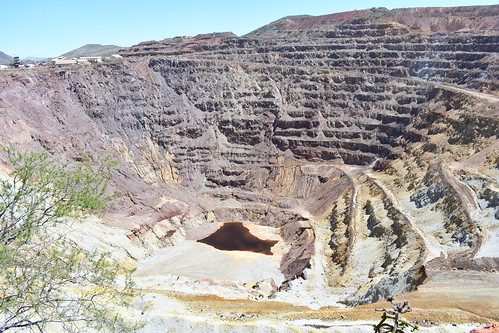
Lavender Pit
Within a couple of decades of discovering surface deposits in1877, Bisbee had become the largest city between St. Louis, Missouri, and San Francisco, California, with a wide array of venues— a stock exchange, over 50 bars and saloons, a plethora of brothels, elegant homes, and Arizona's first golf course. After the mines shut down in the mid-1970s, the town became a haven for hippies and artists. Nowadays, the city attracts visitors seeking a slice of America's past.
Bisbee Tour Company Golf Cart 90-Minute Town Tour
After checking into the conveniently located BTC Lofts on Naco Road, we greeted our guide, Steve, a local with a historical perspective. His great grandfather had worked in the mines during the early part of the twentieth century, and his family has remained in the area ever since that time.
Steve adeptly maneuvered his oversized golf cart up and down the narrow winding streets filled with historic structures and steep staircases. The city capitalizes on the number of steps by hosting its annual Bisbee 1000, the Great Stair Climb, on the third weekend in October.

Bisbee Tour...one of many steep staircases
We stopped every now and then to gain an appreciation of the town's history as Steve recounted many details. Even though significant portions of the wooden buildings were engulfed in flames during a 1908 fire, numerous vintage structures still remain intact. About midway through the tour, Steve drove us to a point where we could look down on the town and simultaneously gain an appreciation of the surrounding mountains.
In 1980, the Bisbee Historic District was added to the National Register of Historic Places, and in 2010, the Bisbee Residential Historic District was subsequently added.
If you're looking for a small southwestern town with a plethora of architectural styles and a fascinating history, add Bisbee to your list.

Bisbee Panoramic View
Queen Mine Tour
Upon arrival, we were outfitted with safety gear—a blue-colored hardhat, a lime-colored vest, and a high-intensity flashlight suspended around our necks. As we waited for the other participants to arrive, we walked through the small collection of informative exhibits in the Visitor Center.
Our guides, former Phelps Dodge Corporation (PDC) employees, led our small group to a nearby vehicle, an open-air train car pulled by a motorized red engine. The PDC closed the underground mines in 1975, and then renovated a portion of the tunnel to open as a tourist attraction.
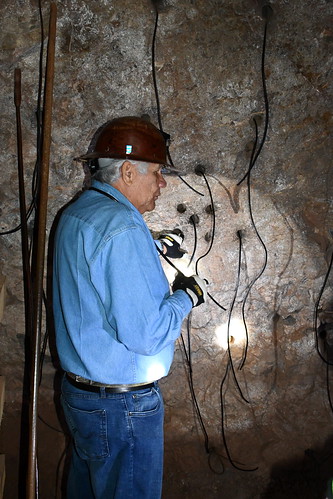
Demonstration of setting dynamite inside Queen Mine Tour
All participants straddled a cushioned narrow seat and were instructed to keep their feet on the floorboards. Within a couple of seconds, a bell rang and the car lurched forward. We were immediately consumed by the darkness of the mine. We breathed in a musty odor and heard clanking sounds as our hour-long tour began.
Demonstrations and brief talks occurred at select locations along the route. Having guides with first-hand knowledge of mining techniques and safety precautions added to our tour's authenticity. We stood before carts that were initially hauled by a team of mules. By the 1920s, technological advances led to the use of motors that were continually upgraded over time.
We learned about the use of cotton and pencil erasers to minimize hearing loss, and the watering down of the limestone laced with silicon to reduce the dust that caused respiratory ailments.
Our guide also showed us several machines used in the mines, described the different methods used to expand the mine, demonstrated how the miners safely used dynamite, explained the use of the internal elevator system, and talked about safety precautions, especially the signaling system mandated by the State of Arizona.

Demo of Signaling System inside Queen Mine
The tour sparked an abundance of questions that were patiently answered by our knowledgeable guides who had spent decades working in area mines.
Bisbee Mining and Historical Museum
After experiencing two tours, we were eager to learn more about the local history. The Bisbee Mining and Historical Museum, located in the former corporate headquarters of the Copper Queen Consolidated Mining Company, helped fill in the gaps. This museum was the first rural affiliate of the Smithsonian Institution.

Inside the Mining and Historical Museum
Even though the museum is small, we could easily have spent hours looking at the artifacts, black and white photos, display cases of minerals, dioramas depicting life in Bisbee, and reading through all of the display boards. The museum also has a few hands-on exhibits designed for school-aged children.
Life inside and outside the mines along with facts about local personalities and businesses shed light on the town's early history and its connection to the mining industry. The copper diplomas that were handed out to Bisbee High School graduates caught our attention. Another striking detail worth mentioning is that "During a century of mining Bisbee miners cut more than 2,000 miles of passageways through a block of the earth three miles long, two miles wide, and nearly a mile deep."

Bisbee Mining and Historical Museum sample of Copper Diplomas given to HS graduates
While the museum highlights local history, some exhibits expose a broader picture demonstrating how the mining industry and the railroads impacted the entire country.
1902 The Spirit Room and Saloon in the Copper Queen Hotel
Directly across the street from the museum is this refurbished hotel and restaurant. As we walked into the lobby and then into the entryway to the restaurant, we felt like we had been jettisoned back to the early years of the 20th century. While many consider the hotel haunted and record unexplained events, others are more interested in its rich history and turn of the century architecture and interior decorating.
Mechanical issues prevented a cooked breakfast. We gladly returned for lunch later in the day. The pleasant and accommodating service made up for our earlier disappointment. The restaurant's modern cuisine seemed out of place in a dining room that took us back to the early 20th century.
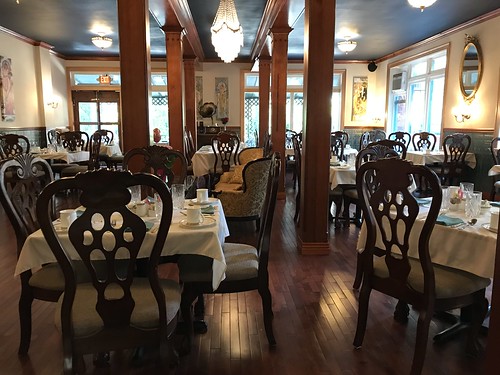
1902 The Spirit Room in Copper Queen Hotel
SIERRA VISTA
Sierra Vista (Spanish for Mountain View) is located about 15 miles north of the Arizona—Mexico border. The surrounding mountains and the climate create an ideal environment for birders. The town has the distinction of being the Hummingbird Capital of the U.S.. History buffs will not be disappointed. During our visit, we visited two places that reveal Sierra Vista's early years.
Coronado National Monument
In 1941, on the 400th anniversary of Francis Vasquez de Coronado's expedition to the area now known as the United States, the U.S. Congress designated this site as the Coronado International Memorial. It was anticipated that the Mexican government would create a park on the other side of the border similar to the arrangement between Glacier National Park in northern Montana and Waterton Lakes National Park in Alberta, Canada. When the Mexican park didn't materialize, the name was changed to the Coronado National Monument.
The main attraction is the location of a pivotal event in U.S. history, Coronado's unsuccessful two-year search for the Seven Cities of Cibola. From a designated spot, it is possible to look down on the valley where a caravan of more than a thousand individuals as well as horses and cattle converged.
For approximately two years, Coronado's expedition traveled from Compostela, Mexico to Salina, Kansas and then returned to Mexico without accomplishing its mission. Unlike Hernán Cortés and Francisco Pizarro González, who defeated the Aztec and the Incan empires, Coronado was unable to locate and conquer a unified Native American civilization or find storehouses of gold. The monument honors this historical moment.
I recommend stopping at the Visitor Center first to get a refresher course on the significance of Coronado's expedition. The background information will put the overlook experience into the proper perspective.

Coronado National Monument View from overlook
Fort Huachuca Museums
Fort Huachuca was constructed in 1877 to guard the region against the Chiricahua Apaches. The fort is also well known for its role as the former headquarters of the Buffalo Soldiers, the U.S. Army's elite African American cavalry corps, and as the current home of Military Intelligence.
Today, the fort is Arizona's last active U.S. Army post and the center for electronic weaponry, communications, and military intelligence training. Since the fort is an active military base, it is necessary to follow entrance requirements. Non-military personnel are advised to check the website for current protocols.

Fort Huachuca Musuem Exhibit
We had the pleasure of having a private tour with Tanja Linton, the Media Relations Officer for the Fort Huachuca Public Affairs Office. Tanja escorted us through the Fort Huachuca History Museum, the Buffalo Soldier Plaza, the Fort Huachuca Military Intelligence Soldier Heritage Learning Center, and the Old Post Cemetery.
In front of the first museum, we stopped to look at a bronze sculpture titled Eyes of the Enemy. Tucson artist Bates’ sculpture honors the Apache scouts at Fort Huachuca who assisted cavalry officers during the Indian Wars.
Inside the museum, we looked at displays that mainly covered the period from the mid 19th century through World War II, and also saw a few exhibits focusing on the Native American communities that inhabited the region before the soldiers arrived. It is an excellent place to learn about the Buffalo Soldiers and their storied contributions to American history.
Nearby, we paid tribute to the Buffalo Soldiers by walking in the Buffalo Soldier Legacy Plaza honoring the African Americans who served with distinction at Fort Huachuca from 1892-1946. A Buffalo Soldier statue stands solemnly at the far end of the park.
We drove a short distance to the second museum located inside a library. This very impressive collection covers the evolution of military Intelligence from the Revolutionary War through the Global War on Terrorism. Documented aspects of spy tactics and surveillance, as well as lesser-known facts, are displayed.
While hot air balloons were unsuccessfully used for reconnaissance missions during the Civil War, the idea of having a bird's-eye view of a battlefield led to geospatial Intelligence. Women and slaves frequently provided valuable information to Union commanders. While Harriet Ross Tubman's name is synonymous with the Underground Railroad, fewer are aware of her activities as a spy and a leader of scouts for the Union Army.
During World War II, Camp Ritchie in Maryland was the place where thousands of German and European Jews, who became known as Ritchie Boys, underwent a specialized training that utilized their language skills and their understanding of Germany.
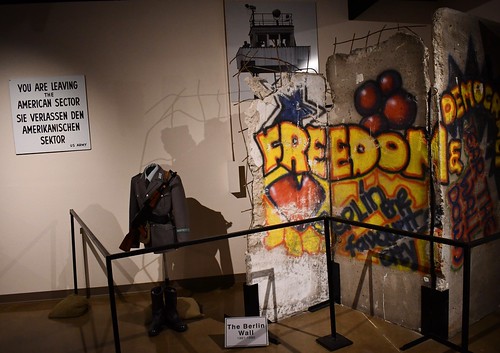
Fort Huachuca Museum Section of the Berlin Wall
The U.S. Army's first unmanned aerial vehicles (UAV), or surveillance drones, were tested at Fort Huachuca from 1955-1961. Since 1987, Fort Huachuca has been the army's central training center for soldiers operating and repairing unmanned aircraft systems or UAS.

Fort Huachuca Museum Army's 1st UAV Drone the SD-1
Before leaving the military base, we drove to the cemetery, where deer openly pranced amongst the graves. Not only did we see row and rows of gravestones for military personnel, but also passed by the graves of infants who didn't survive the harsh realities of living on the frontier in the 19th century. The graves date all the way back to 1877.
We walked away from our fort experience with a renewed sense of patriotism and pride in our country.

Fort Huachuca Museum High Frequency Signal Intercept Station c. 1980
Civilian visits to the fort will require extra time to adhere to the government's rules, but the efforts are worth it. The information gained from our tour added immensely to our understanding of American history.
WILLCOX
A well-regarded wine festival and a selection of quality wine tasting rooms lured us to the small town of Willcox. With only a few hours devoted to the consumption of wine and food, we had enough time to explore some of the historical aspects of the area.
Back in the late 19th century, the Southern Pacific Railroad brought commerce and ranchers to Willcox. By the early 20th century, the town was called the "Cattle Capital of the World.”
Willcox Pioneer Cemetery
Thankfully, Google maps came to the rescue and helped us find our way to this obscure location just outside of town. The weed-infested cemetery appeared as if no one had ventured past the gate in several years.
We heeded the warnings of several online stories mentioning rattlesnakes by walking gingerly on the sandy ground while looking for Warren Earp's gravestone. Like so many famous cowboys, Wyatt’s younger brother and the youngest of the famous clan, was killed in a gunfight that began as an altercation in a saloon. Today, the Flying Leap Tasting Room sits on the former site of the Headquarters Saloon. A weathered plaque on the outside wall of the building memorializes this tiny fact.
The writing on the wood and stone grave markers had faded with time just like the memories of those who were laid to rest in this desert field.
Rex Allen Arizona Cowboy Museum
Rex Allen (1920-1999) grew up in Willcox. He achieved a remarkable career in music, movies, and television, but didn't forget his heritage. In the 1950s, Allen starred in 19 Republic Pictures movies. Since 1951, the town has celebrated Rex Allen Days in October with parades, rodeos, and stage shows.
The museum was opened in 1989 to showcase Allen's life and career as well as his son's (Rex Allen, Jr.) performing successes. Part of this museum also pays tribute to individuals who were involved in the local cattle industry. Not surprising, only a handful of women found their place in the Cowboy Hall of Fame exhibit.
The memorabilia and artifacts single out Rex Allen's early days in Willcox, as well as the high points of his career. He posed with many famous people, including former President Ronald Reagan. Celebrity status during his lifetime is quite different from today.
Historic Downtown Willcox Walking Tour
The Willcox Chamber of Commerce & Agriculture created a pamphlet with a map that outlines both public and private historic buildings in downtown Wilcox, along with a list of noteworthy homes. Take special note of the Willcox Commercial, the oldest continually operating store in Arizona, and the restored Southern Pacific Depot constructed in 1880. The stick style redwood frame building was restored in 1998.

Willcox Commercial
Chiricahua National Monument (about 35 miles from Willcox)
Near the Visitor Center, we stopped to look at a small family cemetery dedicated to the memories of the Erickson Family. These Swedish immigrants established one of the first permanent settlements in the area and were later responsible for opening a guest ranch. The Erickson's Faraway Ranch home was purchased in 1887. The house and adjoining land were sold to the National Park Service in 1979. People interested in Arizona history can take a ranger-led tour of the Faraway Ranch House during the designated tour hours.
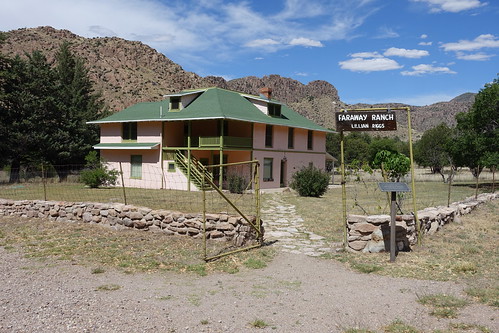
Chiricahua National Monument Faraway Ranch House
With 17 miles of hiking trails and scenic overlooks, this national park offers an informative introduction into southeast Arizona's sky islands— mountain ranges separated by valleys, grasslands, and desert. At Chiricahua National Monument, these remarkable formations resemble pinnacles or spires.
BENSON
Horseshoe Café & Bakery
On our last morning in Cochise County, we found our way to this historic restaurant dating back to the 1930s. A large neon sign makes it nearly impossible to miss along historic U.S. 80. Upon entering, our attention was immediately fixated on a neon horseshoe that spans almost the entire ceiling in the main dining room.
The décor of this diner is mid-twentieth century. The walls are filled with black and white images from an earlier time. The menu has all American favorites served in generous portions.

Benson Horseshoe Cafe Postcard from 1942. Courtesy of Bob Nilson at the Benson Tourism Office
During our brief visit, we could only experience a portion of the county's historic attractions. But as we traversed from city to city, we gained insight into the area's history from the time of Coronado's expedition to the present. While our understanding of the region is far from complete, our visit made us aware of some of the unique places where history comes alive in Cochise County, Arizona.
Sandy Bornstein, the History Comes Alive Through Travel Editor for Wandering Educators, has visited more than 40 countries and lived as an international teacher in Bangalore, India. Sandy’s award-winning book, May This Be the Best Year of Your Life, is a resource for people contemplating an expat lifestyle and living outside their comfort zone. Sandy writes about Jewish culture and history, historical sites, family, intergenerational, and active midlife adventures highlighting land and water experiences.
All photos courtesy and copyright Sandy Bornstein
Note: The Cochise County Tourism Council hosted the author's visit to Cochise County. All of the opinions expressed in this post are based on The Traveling Bornstein's experiences.
